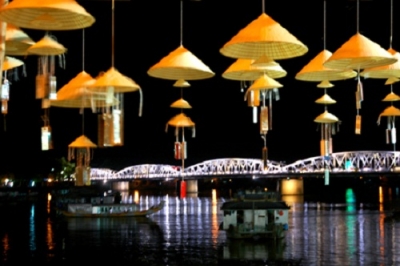Hat-making village Phu Cam (also Phuoc Vinh) lies on the southern bank of the An Cuu River in the centre of the former imperial capital of Hue. It`s a village famous for its traditional way of making conical hats for hundreds of years.
Phu Cam-made hats look graceful, soft and thin as silk. Hue landscapes or even poems can be seen clearly through the hats in the sunshine. It takes woman much time to make the frame and iron leaves before young girls start sewing. The beauty and grace of a hat depend much on the frame (made of 16 brims from the hem to the top). Artisans use sharp knives to prepare the brims and make the frame that needs skills, techniques and experiences, as well as mathematical calculations which have been handed down for generations.
Leaves to make hat play a vital part, leaves have to be blue-white, neither too young nor too old. Collected leaves are to be put to dry in the sun, put to be moistened by dewdrops, and then to be ironed flat on a steel- plank above a kiln, cleaned with a towel. After all this, leaves are cut to fit the frame.
How to arrange the leaves on to the frame is not easy. Each hat needs 50 leaves and between the leaves are coloured papers with pictures or paintings of landscapes, or even poems. Hat-makers are hardworking, careful, and diligent. Hats are served with silk-threads and the chin-straps are made of coloured silk (black, white, yellowish, purple, violet...) to harmonize with Hue climate and beauty.
Poem-hat is a distinctive feature of culture in Hue. Locals say they like to do the job not only to earn money but to preserve their age-old tradition as poem-hats have been absorbed into folk music and songs. Today hats are still used by young girls to shade their heads in the sun and to make them look more graceful in the traditional Ao Dai (long dress).






































































































